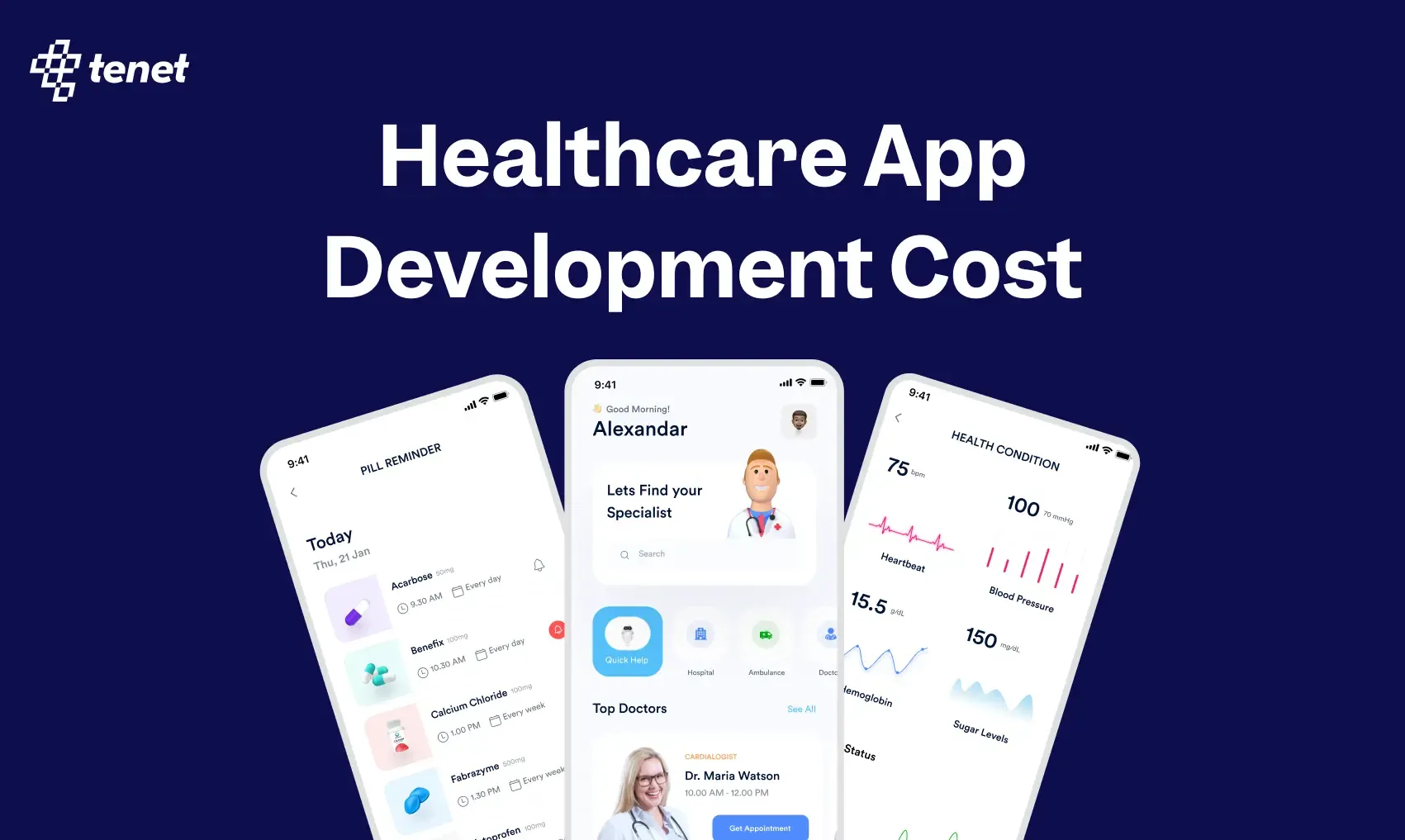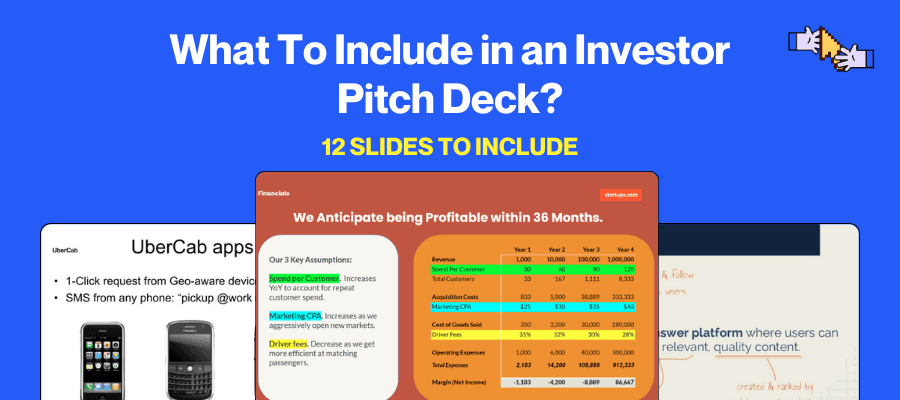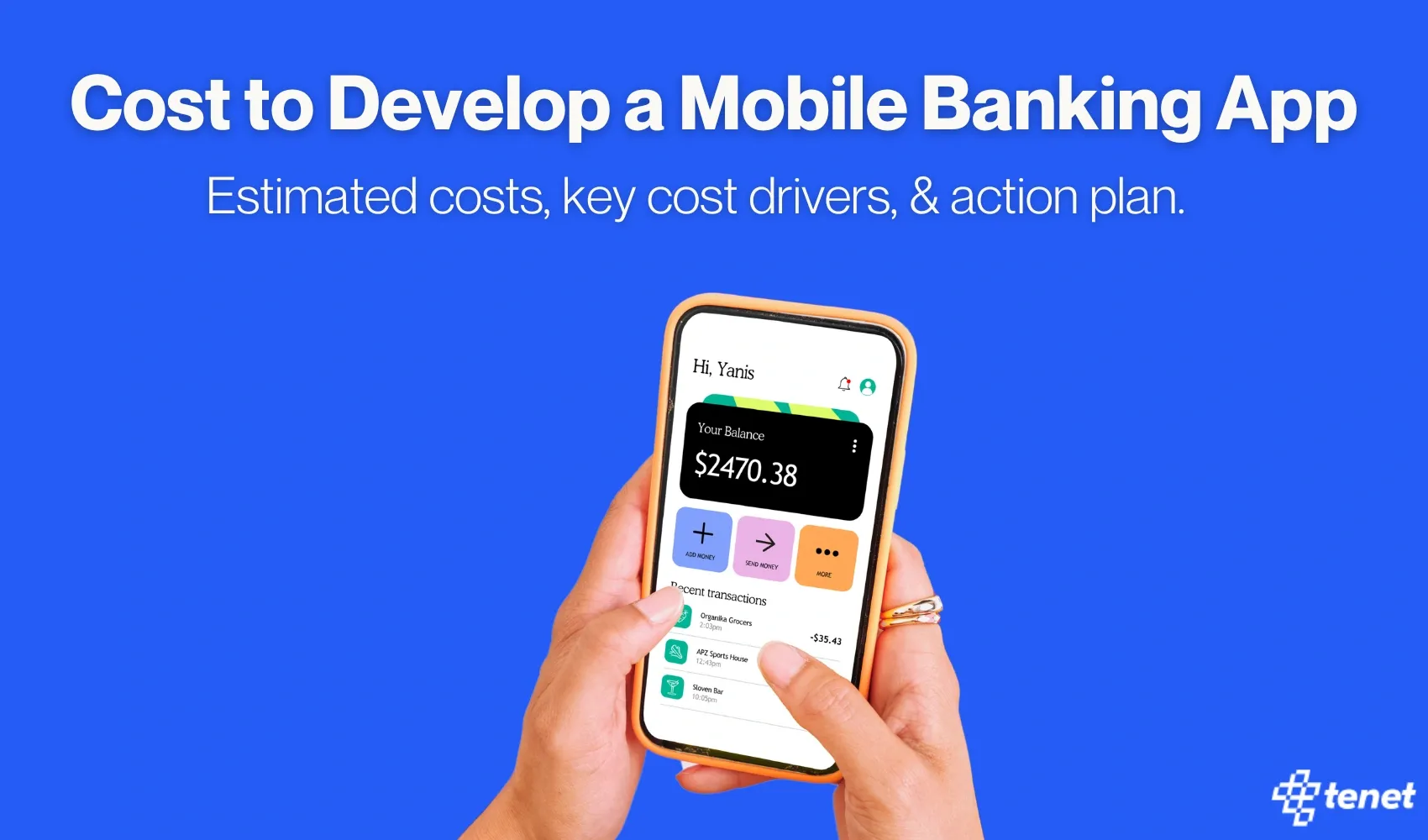80+ Web Accessibility Statistics to Know in 2026
Share
Share

Web accessibility ensures that everyone, including people with disabilities, can use websites without barriers.
In 2026, accessibility is more important than ever as billions rely on the web for daily tasks, shopping, and communication.
This listicle roundup highlights key web accessibility statistics and trends that every website owner should know.
We have curated these insights from trusted online sources and our own extensive research. All source URLs are listed at the end of the article for transparency and further reading.
Key Highlights: Website Accessibility Statistics 2026
- 96.3% of websites still fail basic accessibility standards, showing that most online platforms remain difficult to use for people with disabilities.
- The average website homepage has 51 accessibility errors, many of which could be fixed easily with proper alt text, contrast, or labeling.
- Around 1.3 billion people (16% of the world’s population) live with a disability that affects how they use the internet.
- About 55.5% of website images lack alt text, leaving millions of visually impaired users unable to understand visual content.
- 73% of disabled users abandon a website if it is difficult to use or navigate, proving that accessibility directly affects engagement and sales.
- Businesses lose an estimated £120 billion each year in the UK due to inaccessible online stores where disabled shoppers abandon their carts.
- Globally, businesses could unlock $13 trillion in market opportunity by improving accessibility and disability inclusion.
- 46% of U.S. adults use voice assistants like Siri or Alexa regularly — showing how voice-friendly and accessible web design is becoming mainstream.
- Around 10.8% of people have cognitive or learning disabilities, which makes clear layout, simple text, and structured navigation critical.
How is rising global internet use shaping the need for web accessibility?
Before understanding web accessibility, it’s important to know who uses the internet and how people access online content. In 2025, internet use is higher than ever, and most people browse on mobile devices. These numbers show why every website should be easy to use and accessible for everyone, no matter their device or ability.

- Around 5.56 billion people, or 67.9% of the world’s population, use the internet in 2025. This means more than two out of three people depend on the web for daily information, services, and shopping.
- 60% of all internet traffic now comes from mobile devices, showing how users prefer small screens for browsing and transactions.
- Nearly 92.1% of people use mobile phones to go online, which means mobile-friendly and accessible design is no longer optional.
- About 82% of users go online mainly to solve problems, such as finding information or completing quick tasks. A confusing or inaccessible site can stop them from doing this.
- In the United States, half of all internet users use voice search daily, which makes voice-friendly design and alt text more important.
- The browser Google Chrome remains the most popular, used by 65.7% of global users. This shows why testing accessibility features across Chrome and its extensions is key.
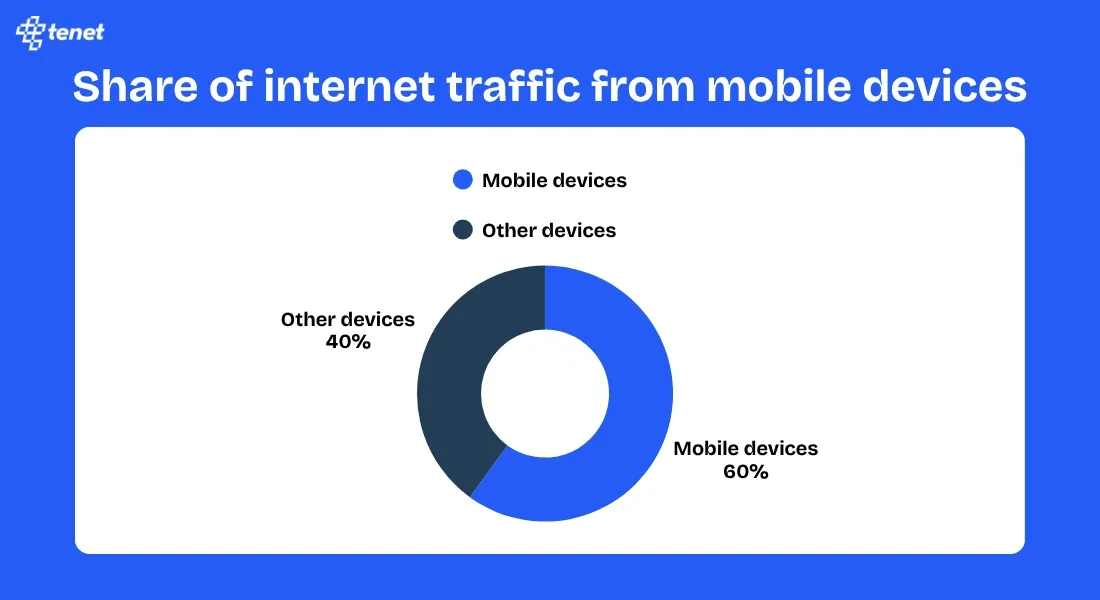
- Around 68.6% of men and 63% of women across the world use the internet, showing a fairly balanced digital presence between genders.
- Over 5.35 billion people actively use social media platforms, where accessibility features like closed captions and readable fonts help millions participate online.
How many people around the world rely on accessible websites every day?
Web accessibility is important because millions of people live with some form of disability that affects how they use the internet. These disabilities may involve vision, hearing, movement, or learning challenges. The following numbers show how large this group is and why websites must be designed to include everyone.
- About 16% of the world’s population, or 1.3 billion people, live with a disability that affects daily life and online access.
- In the United Kingdom, 1 in every 4 people (around 16.1 million individuals) has a disability, making accessible websites vital for public and private services.
- In the United States, 4.9% of adults have serious vision problems or blindness, showing how important readable text and screen reader support are.
- Around 5.7% of U.S. adults are deaf or have serious hearing difficulties, which makes captions, transcripts, and visual alerts essential for web content.
- About 10.8% of people live with cognitive or learning disabilities, which affect memory, focus, and understanding of complex web pages.
- More than 2.2 billion people worldwide experience some form of vision impairment, meaning clear contrast and text readability are key features of good design.
- Nearly 430 million people around the world have disabling hearing loss and depend on visual cues and written communication.
- By 2050, around 2.5 billion people are expected to have some level of hearing loss, showing that the need for accessible web audio will continue to rise.
What online barriers do people with disabilities continue to face?
Even with so many people online, not everyone has the same level of access. Many people with disabilities still face problems like slow internet, a lack of devices, or websites that are hard to use. This digital divide makes it difficult for them to enjoy the same online experiences as others. The numbers below show how big this gap still is.
- Only 26% of Americans with disabilities have high-speed internet at home, which limits their ability to use modern websites, video calls, or streaming services.
- Around 15% of people with disabilities never go online, while only 5% of people without disabilities say the same. This shows how barriers in cost, confidence, and accessibility still exist.
- About 59.6% of U.S. people with disabilities live in homes that have an internet connection, compared to much higher numbers among those without disabilities.
- Nearly 72% of adults with disabilities own a smartphone, but many apps and mobile websites are not designed for assistive tools like screen readers.
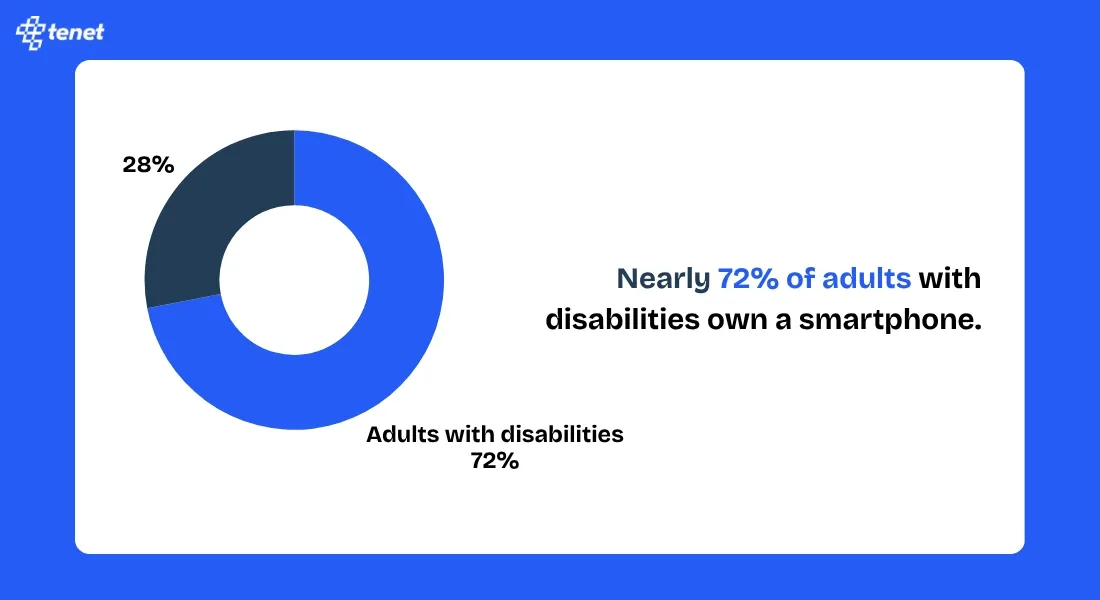
- Only 62% of people with disabilities feel confident using digital devices, compared to 81% of those without disabilities, showing the need for simpler, clearer web design.
- About 18% of all U.S. adults report living with some form of disability, showing how common accessibility needs really are.
- People with disabilities are three times more likely to be offline than people without disabilities, which keeps them from accessing jobs, education, and online services.
- The United States alone has more than 84 million disabled internet users, many of whom rely on accessible websites to shop, learn, and connect with others.
How many websites still fail to meet accessibility standards in 2026?
Every year, WebAIM (Web Accessibility in Mind) studies the homepages of the world’s top one million websites. The goal is to find how many sites follow accessibility rules and where they fail. The 2025 report shows that most websites still have major accessibility problems, even though the numbers are improving slightly each year.
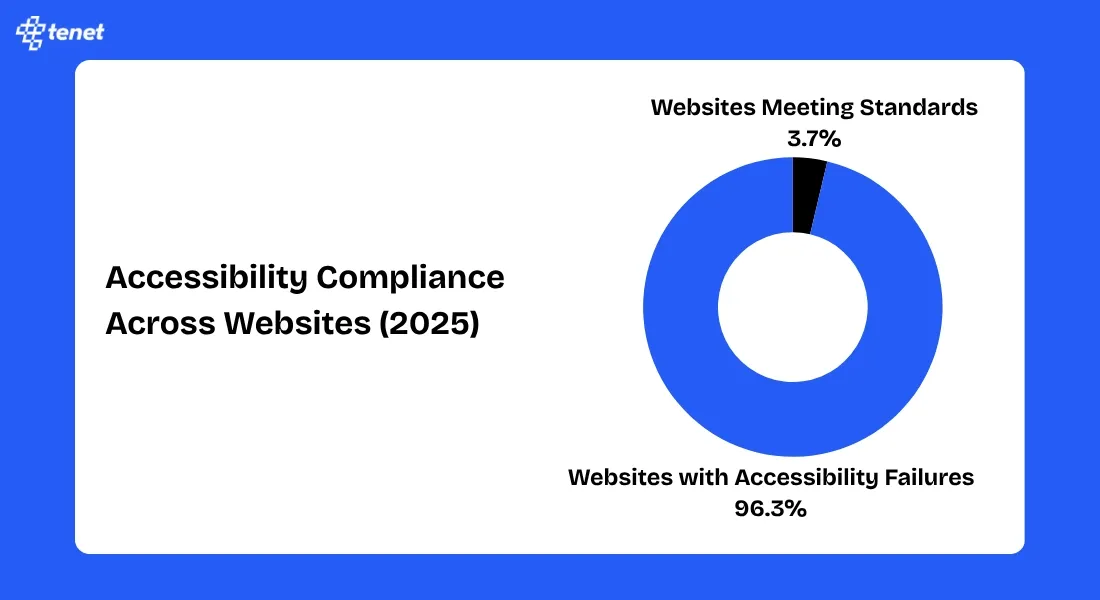
- In 2025, 96.3% of websites still have at least one detectable accessibility failure, meaning only a small share of the web meets accessibility standards.
- On average, each homepage has around 51 accessibility errors, creating multiple barriers for users with disabilities.
- Across one million websites, researchers found over 50 million distinct accessibility errors, proving that the problem is widespread.
- The number of errors decreased by 10.3% compared to 2024, showing slow but positive progress toward better web design.
- Websites built with HTML5 had 15% more accessibility errors than other page types, possibly because of more complex layouts and design features.
- Pages that used ARIA (Accessible Rich Internet Applications) code incorrectly showed 70% more detectable errors, adding confusion for assistive tools like screen readers.
- About 86% of homepages use a valid HTML5 doctype, but these pages still have a higher number of elements and more accessibility problems than simpler sites.
What are the most common accessibility mistakes businesses make online?
Not all accessibility problems are the same. Some issues, like poor color contrast or missing image descriptions, appear on millions of websites. These problems make it hard for people using screen readers or those with low vision to browse or understand content. The following data shows the most common errors found on websites worldwide.

- Around 79% of homepages have low-contrast text, which makes reading difficult for people with color blindness or low vision.
- About 55.5% of images on websites don’t have alt text, meaning screen reader users can’t understand what the image shows.
- Nearly 45.4% of homepages include empty or broken links, which confuse both visitors and assistive technologies.
- Around 39% of websites have unlabeled form inputs, stopping users from knowing what information to enter in fields like “name” or “email.”
- Another 39% of websites have broken heading hierarchies, making it hard for screen reader users to navigate through content properly.
- A large 92% of U.S. federal websites fail to meet basic accessibility standards, even though they serve millions of people every day.
- About 70% of websites in the government, news, and e-commerce sectors are inaccessible to people with vision disabilities.
- Almost 96.5% of detected accessibility errors come from six recurring problems, like low contrast, missing alt text, empty links, unlabeled inputs, missing buttons, and no language tags.
- The Food and Drink industry has shown progress, reducing homepage errors from 66.1 in 2020 to 46.4 in 2024, but accessibility gaps still exist.
Is the internet becoming more accessible, and where is progress happening?
Even though many websites still have accessibility issues, there has been a steady improvement in recent years. More companies and public institutions are learning about web accessibility and updating their designs to meet user needs. These numbers show how accessibility is getting better and which areas are leading the change.
- The share of images missing alt text improved from 68% in 2019 to 55.4% in 2022, showing that more sites are adding image descriptions for screen readers.
- From 2023 to 2024, the average number of accessibility errors per homepage dropped by 10.3%, a positive sign of progress.
- The overall failure rate fell slightly, from 96.8% in 2022 to 96.3% in 2023, meaning a small but steady rise in accessible websites.
- In the United Kingdom, 68% of public sector websites are now at least partially or fully compliant with accessibility rules.
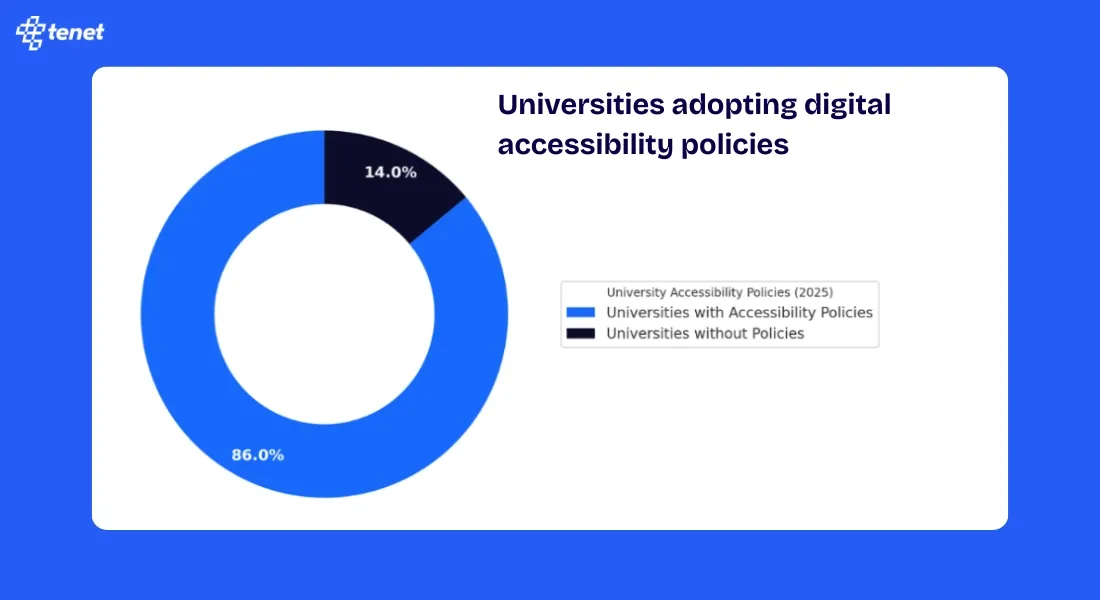
- Around 86% of universities across the world have started implementing or formalizing digital accessibility policies for online learning.
- The public and education sectors are improving faster than private businesses because of government monitoring and compliance checks.
- By 2024, accessibility monitoring programs had expanded to more than 50 countries, helping identify and fix local web issues.
- The Food and Drink category saw the most progress, reducing accessibility errors by almost 30% between 2020 and 2024.
Which assistive tools and screen readers do people with disabilities use most?
People with disabilities use different tools, known as assistive technologies, to access and understand web content. Screen readers, voice assistants, and navigation shortcuts help them read text, describe images, and move around pages. The data below shows how these tools are used and what features make a website easier to access.
- VoiceOver, Apple’s built-in screen reader, is the most used assistive tool, helping 71.5% of users read and navigate web pages easily.
- Google’s TalkBack comes next, used by 29.1% of people who rely on screen readers for Android devices.
- Around 71% of users use more than one screen reader, showing that people often switch tools to get a smoother experience.
- Nearly 39% of screen reader users use three or more readers, depending on the website or device they are using.
- Most users about 67.7% say they navigate web pages through headings first, which helps them skip to the part they need.
- Around 13.9% of users rely on the “Find” feature to search specific words or sections on a web page.
- About 7.1% prefer to navigate through links, especially when websites have clear and descriptive link text.
- A large 85.7% of users find proper heading levels (like H1, H2, H3) very useful or somewhat useful, proving how important structure is for screen reader access.
How are voice assistants and mobile tools improving web inclusivity?
Voice commands and mobile accessibility tools have become a big part of how people with disabilities use the internet. These tools help users who cannot easily type, move a mouse, or see the screen clearly. The following statistics show how voice and mobile technology are improving web access for millions of people.
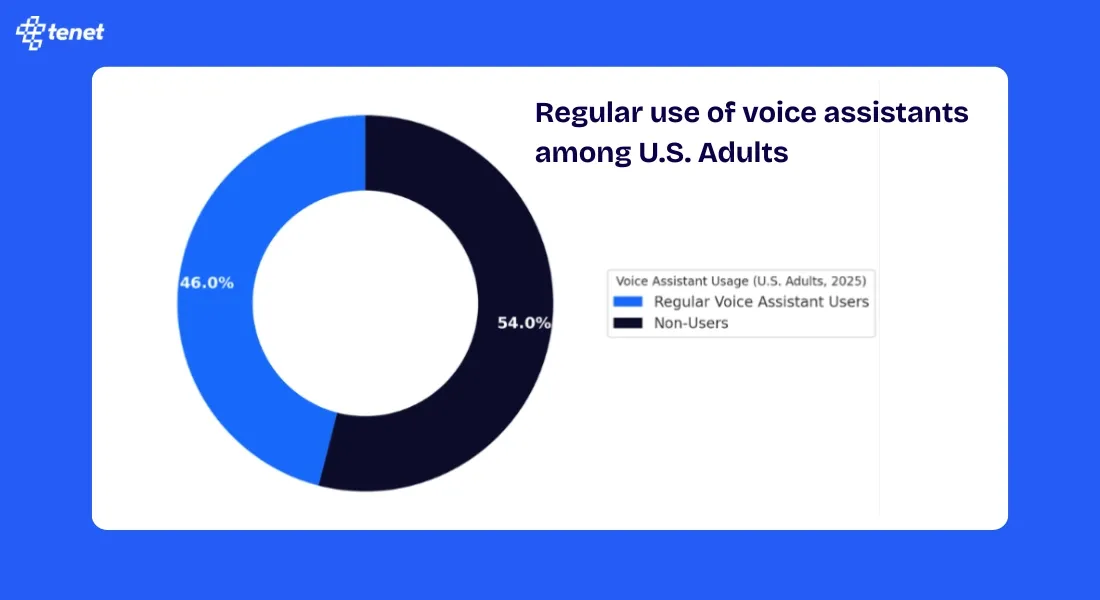
- Nearly 46% of adults in the United States use voice assistants regularly, and usage is even higher among people with visual impairments.
- Voice assistants such as Siri, Alexa, and Google Assistant make it easier for users with vision or motor challenges to browse, search, and control devices hands-free.
- Around 7.6% of screen reader users depend on Voice Assistant software as their main accessibility tool.
- About 6.6% of users use Commentary/Jieshuo, a screen reader app popular among Android users.
- Around 6.1% of people rely on VoiceView, Amazon’s accessibility tool built for Kindle and Fire devices.
- Nearly 3.4% of users use Mobile Accessibility for Android, while smaller groups use apps like Nuance Talks (1%), Mobile Speak (0.5%), and IDEAL (0.4%).
- Another 3.4% of users use lesser-known or custom-built screen reader tools, depending on language and region.
How does accessibility design improve user experience for everyone?
A good user experience (UX) and strong web accessibility often go hand in hand. When a website is easy to use, it helps everyone, not just people with disabilities. Accessible websites load faster, are easier to read, and keep users engaged. The data below shows how poor accessibility affects user behavior and how a better design can improve satisfaction.
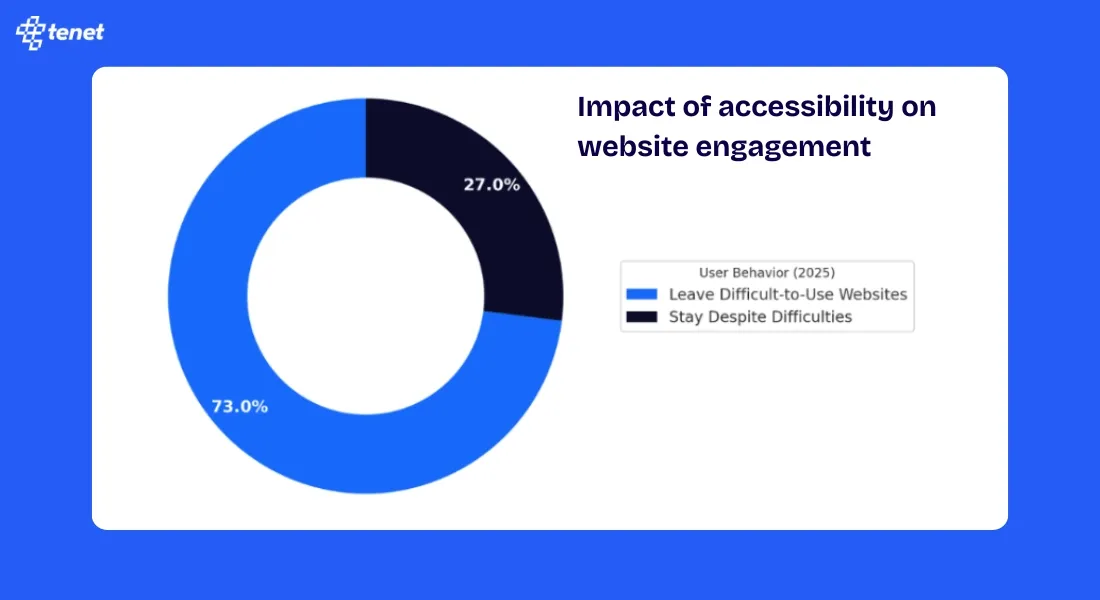
- About 73% of disabled users leave or abandon a website if it is difficult to use, showing that accessibility directly affects engagement.
- Nearly 88% of all users say they are less likely to return to a website after a bad user experience, which includes hard navigation or unreadable design.
- Around 61% of mobile users never return to a site that has poor accessibility or mobile layout problems.
- More than 80% of users are willing to pay more for a smoother, easier online experience, proving the value of accessible design.
- Around 83% of users say that having a consistent and seamless experience across all devices is essential.
- 85% of people believe that a mobile website should be just as good or better than a desktop site, stressing the need for responsive and accessible layouts.
- Accessibility design overlaps strongly with mobile-first UX principles, which means improving accessibility often improves the mobile experience for everyone.
- Studies show that accessibility fixes, such as adding labels and clear structure, help reduce bounce rates and improve time on site.
- It is estimated that 90% of websites are still inaccessible to users who depend on assistive technology, proving that there’s a long way to go.
How does web accessibility affect business growth and revenue?
Making websites accessible is not just the right thing to do, it is also good for business. Accessible design helps companies reach more customers, improve their online visibility, and avoid legal risks. These statistics show how web accessibility affects sales, search rankings, and overall business growth.
- The Purple Pound, which represents the spending power of disabled households in the UK, is worth around £274 billion every year, showing the market value of accessibility.
- In the UK, about 55% of online shoppers with disabilities have abandoned purchases due to poor accessibility, leading to an estimated £120 billion loss for retailers.
- Globally, businesses could unlock nearly $13 trillion in market opportunity by embracing disability inclusion and accessibility.
- Websites that follow accessibility best practices often perform better in search engines because accessibility improves SEO rankings and site usability.
- Increasing UX spending by just 10% can lead to up to 83% higher conversions, proving the link between design quality and business performance.
- Companies that invest in strong design and accessibility grow twice as fast as their competitors in the same industry.
- Fixing accessibility issues early is far cheaper than facing legal action or rebuilding a non-compliant site after a lawsuit.
- Accessible websites create more user trust and stronger brand loyalty, as they show that a business cares about every customer’s experience.
What do current accessibility laws and compliance standards require in 2026?
As more people rely on the internet for their daily needs, governments around the world are implementing web accessibility laws. These laws protect the rights of people with disabilities and hold organizations responsible for maintaining accessible websites. The following statistics show how legal action and compliance rates have changed in recent years.
- In 2023, 4,605 web accessibility lawsuits were filed under the Americans with Disabilities Act (ADA) in the United States.
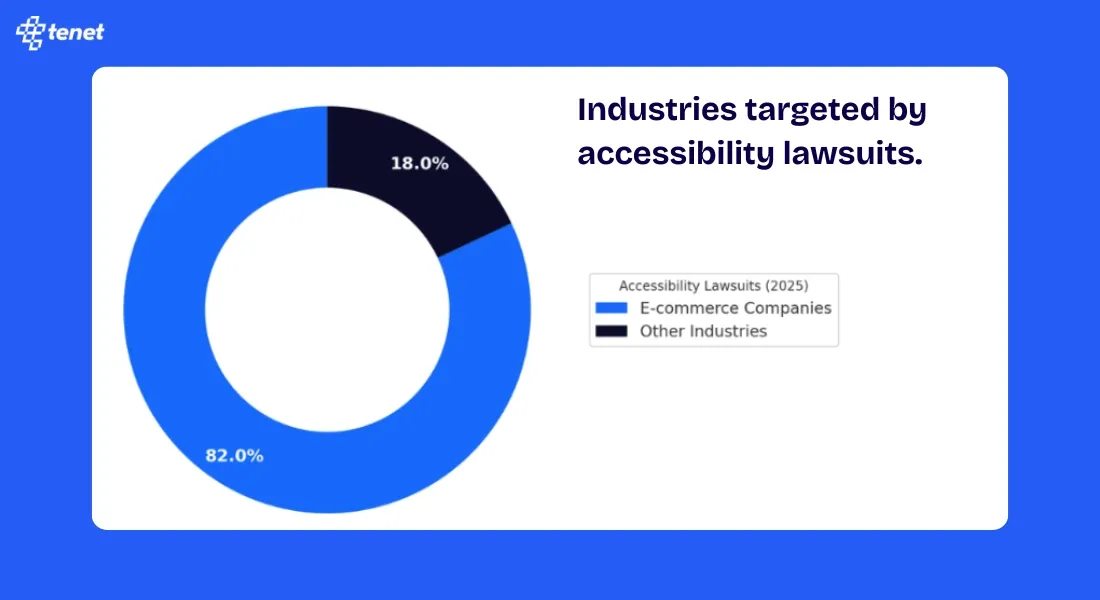
- Around 82% of these lawsuits targeted e-commerce companies, showing how online retailers face the highest legal risk.
- About 26% of the companies sued for accessibility issues had been sued before, which highlights the lack of long-term compliance.
- Nearly 80% of U.S. hospital websites still fail to meet accessibility standards, limiting access to health information for patients with disabilities.
- A large 92% of federal websites in the United States do not meet basic accessibility guidelines, even though they serve the public.
- In the United Kingdom, about 68% of public sector websites have become partially or fully compliant, showing progress under accessibility monitoring.
- The European Accessibility Act (EAA) will require digital accessibility across all EU countries starting from 2025, strengthening global standards.
- Enforcement of the ADA and other accessibility laws has increased every year since 2020, showing that legal systems are taking accessibility more seriously.
- Many organizations now include accessibility audits in their compliance plans to avoid fines and maintain a positive public image.
Final words
The web has become a part of daily life for billions of people, but not everyone can use it easily. Accessibility is no longer just an option; it is a basic need. As we move forward, technology is helping more organizations design websites that include everyone.
Today, 68% of web developers say they have received some training in accessibility tools, and 90% of UX teams plan to make accessibility a key focus by 2026. This shows that awareness is growing across the tech world.
Artificial intelligence is also starting to play a role. AI-powered accessibility testing tools can now scan web pages, find errors, and suggest fixes faster than before. This helps developers save time and maintain compliance with accessibility laws.
Accessibility is also becoming a measure of quality. Google’s Lighthouse tool now includes accessibility scores, rewarding websites that provide inclusive and user-friendly experiences.
By making small improvements like adding alt text, fixing contrast, labeling forms, and supporting screen readers, businesses can open their doors to millions of users. These changes not only help people with disabilities but also improve SEO, conversions, and brand trust.
FAQs
1. What is web accessibility, and why is it important?
Web accessibility means designing websites that everyone, including people with disabilities, can use easily. It ensures equal access to online content, improves user experience, boosts SEO, and helps businesses reach a wider audience while staying legally compliant.
2. How many websites fail accessibility standards in 2025?
In 2025, around 96.3% of websites still fail basic accessibility standards. Most errors involve low contrast, missing alt text, broken links, and unlabeled form fields, making it difficult for users with disabilities to browse or complete tasks.
3. What are the most common web accessibility issues?
The top accessibility problems include low color contrast, missing image alt text, empty links, unlabeled form fields, and poor heading structure. These issues make reading, navigation, and screen reader access difficult for users with vision or cognitive disabilities.
4. How does web accessibility impact businesses financially?
Accessible websites attract more users, improve SEO, and reduce legal risks. Inaccessible design can cause major losses — for example, UK retailers lose about £120 billion annually because disabled shoppers abandon inaccessible websites. Accessibility directly boosts revenue and brand trust.
5. Which assistive technologies help people access websites?
Popular assistive tools include VoiceOver (Apple), TalkBack (Google), and screen readers that read page text aloud. Many users also rely on voice assistants like Siri and Alexa for hands-free browsing and navigation on mobile or desktop devices.
6. What laws support digital accessibility?
Major accessibility laws include the Americans with Disabilities Act (ADA) in the U.S., the UK Equality Act, and the European Accessibility Act (EAA). These require businesses and public websites to meet accessibility standards or face legal penalties.
Data Sources
- https://webaim.org/projects/million/
- https://embryo.com/blog/21-stats-on-why-website-accessibility-is-more-important-than-ever/
- https://www.ons.gov.uk/peoplepopulationandcommunity/healthandsocialcare/disability/articles/outcomesfordisabledpeopleintheuk/2021
- https://business.scope.org.uk/disabled-customers-purple-pound/
- https://www.clickawaypound.com/
- https://info.usablenet.com/2024-year-end-report
- https://www.statista.com/
- https://www.interaction-design.org/literature/article/improve-customer-experience-with-ux-investments-that-increase-roi
- https://www.forrester.com/report/The-Six-Steps-For-Justifying-Better-UX/RES117708
- https://explodingtopics.com/blog/smartphone-usage-stats
- https://saleslion.io/sales-statistics/39-of-people-will-stop-engaging-with-a-website-if-images-wont-load-or-take-too-long-to-load/
- https://comnio.com/blog/2016/07/85-adults-think-companys-mobile-website-good-better-desktop-website/
- https://www.toptal.com/designers/ux/ux-statistics-insights-infographic
- https://inspired444.com/estate-agents-website-design/
- https://uxplanet.org/the-value-of-ux-design-bc22bcd482a4
- https://ddiy.co/wcag-web-accessibility-checklist/
- https://www.statista.com/statistics/617136/digital-population-worldwide/
- https://retailtimes.co.uk/retailers-failing-to-prioritise-accessibility-risk-losing-billions-beyond-the-purple-pound/
- https://webaim.org/projects/million/
- https://www.pewresearch.org/short-reads/2021/09/10/americans-with-disabilities-less-likely-than-those-without-to-own-some-digital-devices/
- https://www.gov.uk/government/publications/accessibility-monitoring-of-public-sector-websites-and-mobile-apps-from-2022-to-2024/accessibility-monitoring-of-public-sector-websites-and-mobile-apps-from-2022-to-2024/
- https://er.educause.edu/articles/2023/8/educause-quickpoll-results-risks-and-opportunities-in-higher-education-accessibility/
- https://socialmarketing90.com/web-accessibility-statistics
- https://webaim.org/projects/screenreadersurvey9/
- https://datareportal.com/global-digital-overview
- https://backlinko.com/seo-stats
- https://themeisle.com/blog/web-accessibility-statistics/
- https://www.who.int/news-room/fact-sheets/detail/disability-and-health
- https://makeitfable.com/insights/insights-the-state-of-online-shopping-for-people-with-disabilities/
- https://www.deque.com/blog/research-shows-internet-is-unavailable-to-blind-users/
- https://www.pewresearch.org/short-reads/2023/07/24/8-facts-about-americans-with-disabilities
- https://www.mckinsey.com/capabilities/growth-marketing-and-sales/our-insights/why-marketers-should-keep-sending-you-emails
- https://www.pewresearch.org/short-reads/2021/09/10/americans-with-disabilities-less-likely-than-those-without-to-own-some-digital-devices/
- https://www.cdc.gov/visionhealth/basics/ced/fastfacts.htm
- https://devblogs.microsoft.com/xamarin/the-journey-to-accessible-apps-screen-readers/https://www.who.int/news-room/fact-sheets/detail/deafness-and-hearing-loss
- https://www.pewresearch.org/short-reads/2017/12/12/nearly-half-of-americans-use-digital-voice-assistants-mostly-on-their-smartphones/
- https://www.forbes.com/sites/forbestechcouncil/2022/05/03/unlock-business-potential-by-improving-accessibility-in-the-workplace/
Make Your Website Accessible and User-Friendly. Get a Free Proposal.
Make Your Website Accessible and User-Friendly. Get a Free Proposal.

Got an idea on your mind?
We’d love to hear about your brand, your visions, current challenges, even if you’re not sure what your next step is.
Let’s talk











